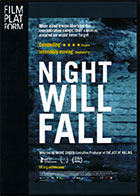
Night Will Fall 2014
Distributed by Film Platform
Produced by Sally Angel, Brett Ratner
Directed by Andre Singer
DVD, color and b&w (archival footage), 75 min.
High School - General Adult
Genocide, Jews, War Crimes
Date Entered: 12/13/2016
Reviewed by Michael Schau, Seminole State College, Sanford, FLThis is the story of the making of a documentary shot during the liberation of the Nazi Germany death camps. Some of the footage we may have seen over the years of the atrocities the freeing of the camps revealed, but these are the longer, original gut-wrenching scenes that showed the world, as General Eisenhower said, ‘What we are really fighting for.” It includes horrifying scenes of the liberation of Bergen-Belsen, Dachau and Auschwitz concentration camps. It was shot by military cameramen of Russia, American and Britain, who had no idea what they would be seeing before they arrived. Skeletal survivors, piles, even acres of starved to death victims whose bodies are dragged to a pit for burial by former male and female SS guards. The civilian population, living in mainly untouched towns surrounding the camps are brought in to view the camp horrors. The victim’s hair, glasses and even teeth were shown in methodically collected piles and sorted to be recycled by the Reich. The scenes were deliberately shot to have well known figures like Generals Eisenhower, Bradley and Patton in it to prove its authenticity in order to refute anticipated German denials.
Later are scenes of the former inmates coming back to life and engaging in day by day acts, like cooking and sorting through clothes.
The producer Sidney Bernstein eventually brought his friend Alfred Hitchcock in to help as a supervising director. However, the war ended so the film was shelved because the current political climate was against it. The Allies needed the German population cooperation to rebuild Germany. It was also politically inconvenient for the British as it might be used by refugees wanting to go to Palestine (Israel) then a League of Nation mandate, controlled by Britain. Its images were used during the Nuremburg war crimes trials and elsewhere to convict Nazi war criminals.
The American government did not agree with shelving the film, and commissioned director Billy Wilder to make a shorter, more damning film from it. It was shown as Death Mills (1945) to the German populace in the Allied zone in 1946. Factual Survey was finally completed 70 years later as Memory of the Camps by the Imperial British War Museum in the manner Bernstein and Hitchcock envisioned. The completed film feature survivors, some of whom identify their younger selves in the film, as well as soldiers who did the filming along with rare archival film and eyewitness testimony. The Museum digitally restored German Concentration Camps Factual Survey with the never seen sixth reel.
This film succeeds as a glimpse into a little known area of history, as an unsparing view of the horrible depravity of the Nazi regime and as documentary.